Last Updated on April 5, 2024
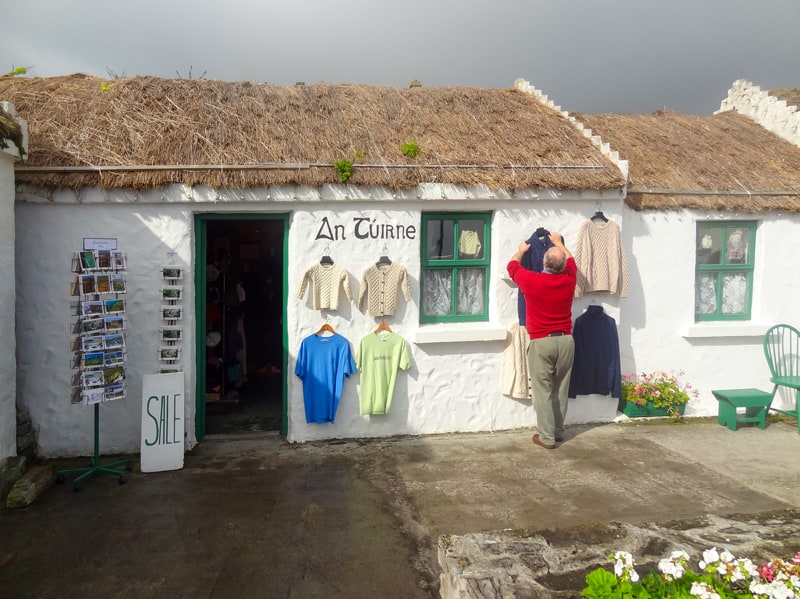
Estimated reading time: 11 minutes
By Jim Ferri
Ever since I was a kid, my young imagination fueled by National Geographic, I wanted to visit the Aran Islands in Ireland.
There are three of the, just off the west coast of Ireland. Inishmore (Inis Mor) is the largest and most visited; Inishmaan (Inis Meáin) the least visited; and Inisheer (Inis Oírr) the smallest. They all looked austere, beautiful, and wild on those glossy pages, showing the wind-whipped majesty of the island’s landscapes.
Still, when I arrived by ferry at Kilronan on Inishmore – at 2 miles by 8 miles the largest and most famous of the trio of Arans – I found the tiny village lush with bushes, trees, and ivy climbing over ancient walls.
It all soon disappeared after I boarded a minibus to take me to my B&B. The trees and bushes vanished and were replaced by a landscape covered with grass. Ribbons of road darted here and there, and stone walls ran in every direction across barren hillsides.
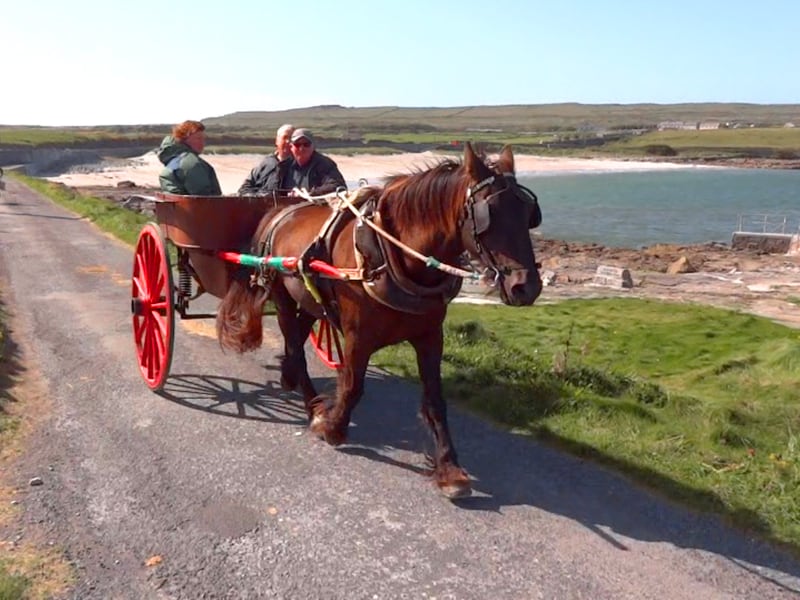
“We Sometimes Have Rough Seas…”
“We sometimes have rough seas, but not today – it’s only windy,” our driver said to me over his shoulder.
That was a surprise to me. During the hour-long ferry ride over to Inishmore on Aran Island Ferries, we rolled back and forth several times in seemingly calm seas. And at one point, the crew handed out seasickness bags. Through it all, though, a group of young German students laughed and cheered as if they were on a carnival ride.
“About 20 days every winter, it’s so rough you can’t get on or off the island by boat,” he continued, “and for another 20, you wish you had.”
I later learned that winter on any of the Aran Islands in Ireland was only for the most hardy. And at times, due to stormy winter weather, the ferry does not sail.
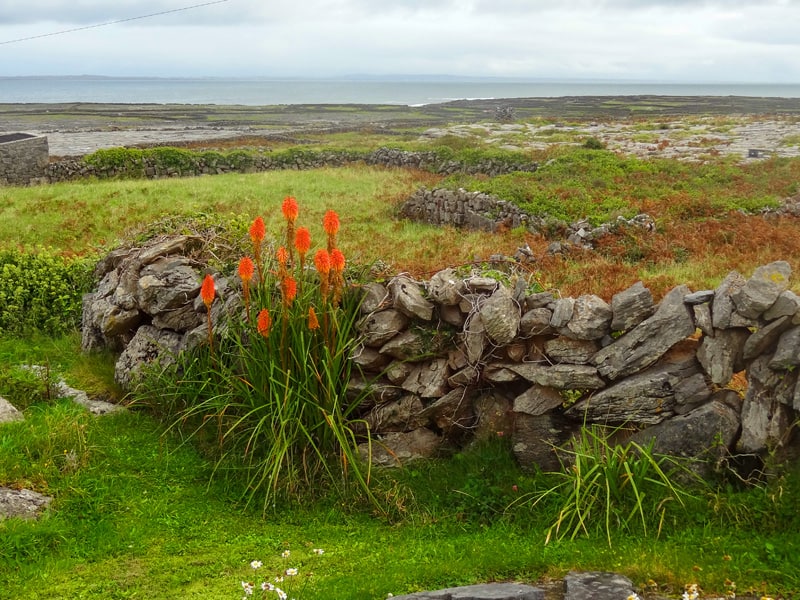
Beautiful September Weather on the Aran Islands, Ireland
It was September when I set off for the Aran Islands, one of the best places to visit in Ireland. I was glad I had come now, for the crowds, numbering about 2,000 per day in July and August, were gone. And the winds of winter, and all they bring to the Aran Islands, hadn’t yet set in.
I sat back and continued to study the landscape that had now become even more austere, a bright green checkerboard of stonewalls with only an occasional house here and there.
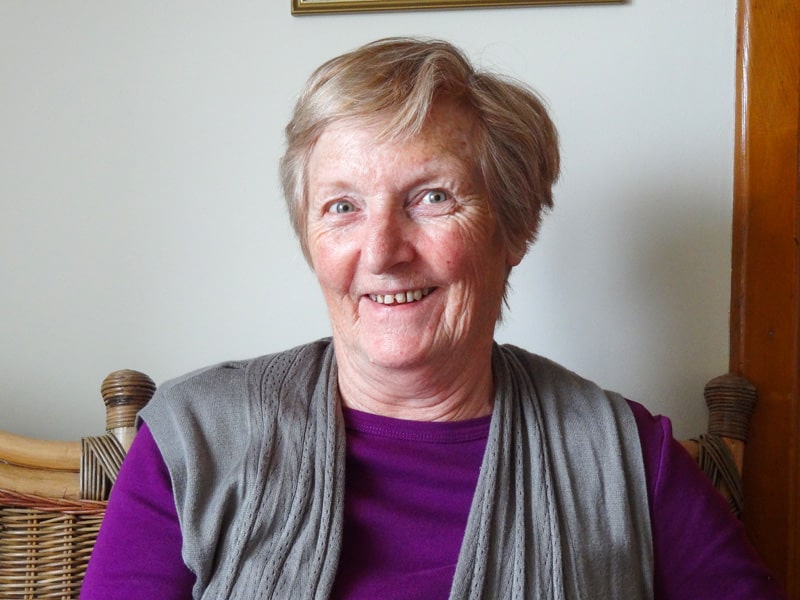
Bridie Conneely of the Beach View House B&B
We dropped off my two fellow passengers at a 200-year-old thatched cottage with a satellite dish attached to the gable. Then the driver headed to the Beach View House, my Bed & Breakfast in Inishmore’s Oatquarter area where the owner Bridie Conneely awaited me. I was looking forward to meeting her since during my travels I’ve come to greatly enjoy Ireland’s Bed & Breakfasts.
Bridie was a lovely looking Irish woman who fit this place so well. She was welcoming and kind, always ready to get me anything I needed. I later learned she had initially come from the Arans but had gone to the US, as so many islanders did. There she married and worked for many years, before returning here with her husband, also an islander. Incredibly, they had been married in the same church in New York as my parents.
Now, though, she showed me to my room, which looked out upon that mesmerizing checkerboard. There was a small grouping of houses in the distance, and since I was only going to be here for 1½ days, I dropped my bags and set out walking towards them.
Discovering Inishmore
I wandered off towards one section of Aran’s seaside cliffs, across a vast flat limestone area so barren that little could grow on it. On my way back, I walked along a bit of road and passed a few houses, one of which had a dog walking atop the stonewall in front of it.
All around, horses and cows grazed in their little checkerboard pastures. It was all tranquil, not a sound except for the wind and the clip-clop of an occasional pony pulling its cart, or traps as they’re known here. They’re sounds you hear on all the Aran Islands in Ireland.
Landscapes often mold one’s personality, and I couldn’t help but notice how taciturn some of the Aran Island men were. You could hear a car coming from a mile away, and after several passed me, I realized that their drivers were treating me as a local since all of the other tourists were either on bikes, rented down at the ferry, or in traps.
As they passed, each would give me an almost imperceptible nod and, from the steering wheel, raise his index finger in a little “hello.” Armed with my new status, I began getting into the Aran Islands’ rhythm, walking for hours on end, setting out for any little distant speck that appeared interesting. I found the austerity of the land and the purity of the air wonderfully exuberant.
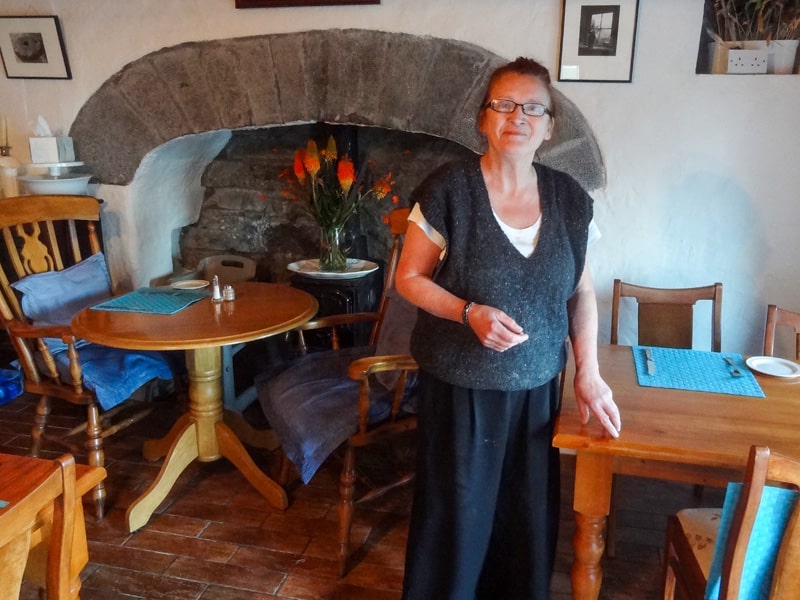
A Wonderful Dinner in “The Man of Aran” B&B
That evening I asked Bridie to suggest where to eat since I hadn’t seen a single restaurant anywhere on my forays. She suggested the Man of Aran Cottage, a restaurant in another B&B. It was about a mile up the road, just past a little scimitar of beach. The house, I discovered, was built for the 1931 movie “The Man of Aran.”
It was a charming little place, filled with flowers and overlooking the Atlantic. On the way in I noticed an award they had won from a B&B Association in the “Best Food” category.
As I sipped a glass of wine, I watched Maura Wolfe, the chef/owner, collect the makings for my salad from her garden. The fading light turned the sky gray and peach, and the aroma from a large rosemary bush hung in the air. The dinner turned out to be even better than the ambiance.
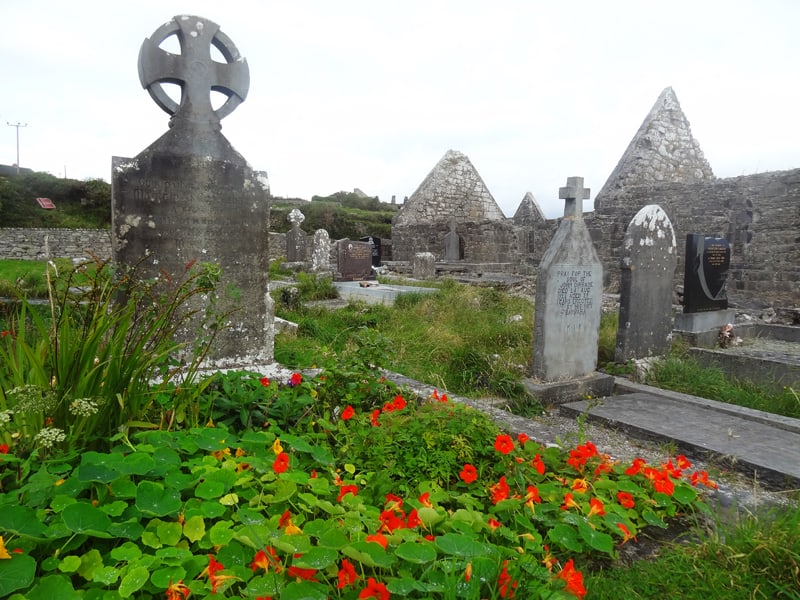
Seven Ancient Aran Churches
I set out the next morning and headed up a coastal road that had intrigued me. It was totally quiet, and I didn’t see a single person for about an hour and a half. I walked out in a pasture along one road and found the tall grass extremely soft. It felt as if I was walking on a feather comforter.
I continued along, soon joined by a playful dog who accompanied me for a while. After I saw an old church down a small hillside, we headed down there, him leading the way. I soon met a man walking his dogs, and we began to chat. He explained there were seven ancient churches in this area and pointed them out to me.
My little friend continued on the road down to the ocean while I headed over to the churches. I found a scattering of old buildings, all surrounded by graves with tilting tombstones. Amazed at how well kept it all was, I then saw a sign saying I was at National Monument 43, a small church started in the 8th century on the Aran Islands in Ireland.
Wandering about the rural cemetery past 100- and 200-year-old tombstones, I then found another sign saying, “This 9th-century cross-slab commemorating the “seven Romans” testifies to the fame of Aran schools, which attracted students from the Imperial Rome.”
The braying of a distant donkey soon punctuated the silence, and reminded me of the time. As I left the churchyard, my canine friend came running back up from the beach to me. About halfway back to Beach View House, he ran around a stone wall and across a pasture, and a few minutes later, I saw him sitting at his master’s door watching me go by.
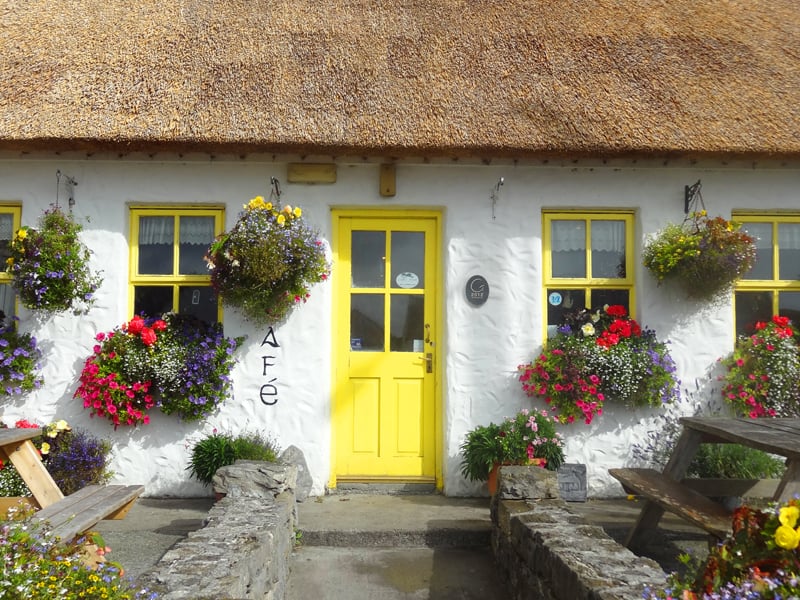
Little Shops and a Café
Not long after, I passed a group of little shops and a café near The Man of Aran Cottage in Kilmurvey. It was 11:30am and it was opening for the first tourist-minivans coming up from the ferry.
The cottage was the drop-off point for many of the mini vans enroute to Dun Aonghusa, a stone fort. The fort was built by Celtic tribesmen around 2000 BC and is now a World Heritage Site. I would have liked to have walked about a bit more but needed to head back since Bridie had called a pony and trap to take me back to the ferry that afternoon (video).
Like Bridie, my trap driver had also been born on the island. He went to work in Boston for some years before returning. We had a friendly chat along the way as he adroitly steered around pedestrians and bicyclists on the narrow road. Occasionally, he would call out in Gaelic to friends in the fields .
Due to their isolation over the centuries, the Arans are still a center of the Gaelic culture and language, and during the summer months, students come here to study. When they leave, I’m certain they hope, as I did, that the seas will be smooth and the memories long-lasting.
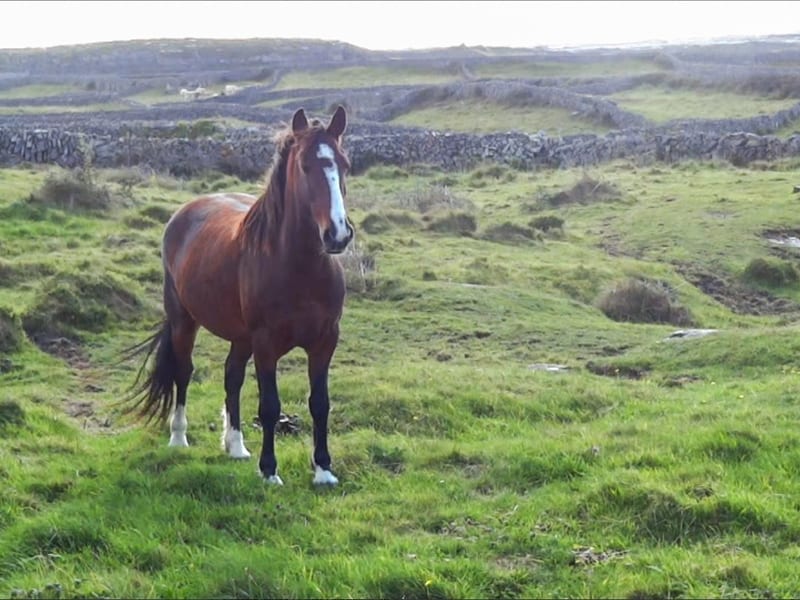
If You Go:
July and August are the most crowded months on the Aran Islands. The best time to visit the islands is “off season” in May-June and September-October. The prices then are generally lower than during the “high season” summer months and the weather is generally wonderful.
How to Get to the Aran Islands
You can get to all three of the Aran Islands by ferry only on Aran Islands Ferries (from Rossaveal, approximately 23 miles west of Galway) or on Doolin2Aran Ferries (from Doolin in County Clare near the Cliffs of Moher).
Aran Island Ferries (Rossaveel Pier Office)
The Pier Ros a Mhil
Connemara,
Co. Galway, Ireland
Tel: +353 (0)91 568903
@ [email protected]
Sailing Season: year-round.
Aran Islands Ferries runs a shuttle From Queen Street in Galway to its terminal in Rossaveel. Roundtrip shuttle fares: Adult €9, Seniors and students €8, children (5-12 years) €6. There is also parking available at the pier at a cost of €7 for 24 hours in case you’ve been touring Ireland by rental car.
Roundtrip fares to all islands: Adult €30, Seniors and students €25, children (5-12 years) €15
Doolin2Aran Ferries
Doolin Pier
Co. Clare, Ireland
@ [email protected]
Tel: +353 65 7075949 / +353 87 2453239
Sailing season: Sailing Season: mid-March to the end of October.
Parking at Doolin pier is €1 for 2 hours, €5 for 2- 30 hours, €15 for 30 hours – 1 week.
Doolin2Aran Ferries sails from Doolin to all 3 Aran Islands, as well as offering a return sailing to Doolin from the islands via the Cliffs of Moher. The crossing from Doolin to Inis Mor takes approx 35 minutes.
One-way fare to Inis Mor is €20; roundtrip overnight stay is €28. See the Doolin2Aran Ferries website for all fares and additional information.

This was a great article about the Arans. Lots of info packed into the descriptions.
I’m glad you enjoyed it Susan. I love the Arans and want to go back some day.
Jim
Hi Jim, thanks so much for the mention!
I bet it was Jim Sugar’s article and wonderful photos in National Geographic that started it all 🙂
Just to let you know, we sail from Doolin to all 3 Aran Islands, not just Inis Mor, as well as offering a return sailing to Doolin from the island via the Cliffs of Moher. The crossing from Doolin to Inis Mor takes approx 35 minutes. We hope to have you back on board again!
All the best, Joan, Doolin2Aran Ferries
Hi Joan,
Thanks for the information. I’ll make a note in the article.
Jim